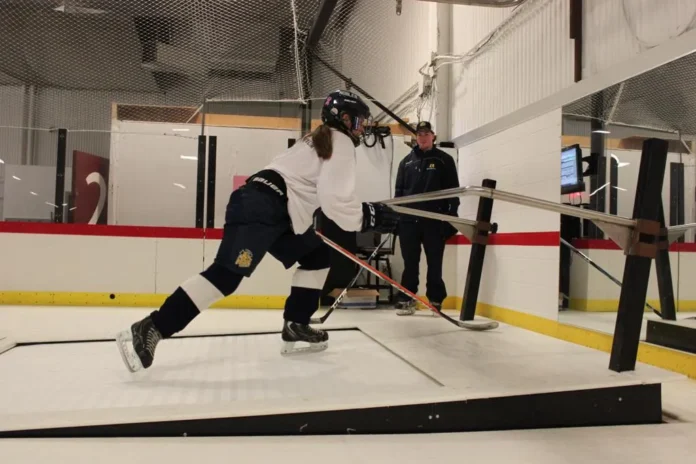Hockey is a game of inches and milliseconds, where skill and speed define champions. While natural talent provides a starting point, it is dedicated, structured training that forges elite players. To master the modern game, players need more than just ice time—they need specialized hockey on ice training equipment that sharpens every facet of their skill set. This guide outlines the tools that transform good players into great ones.
The Importance of Specialized On-Ice Training for Hockey Players
Generic drills and open skates have their place, but true progression comes from targeted practice. Specialized on-ice equipment provides the structure for focused, high-repetition drills that build muscle memory, enhance reaction times, and mimic game scenarios. Without these tools, players risk plateauing and failing to reach their full potential.
Core Attributes: Building Skill and Speed in Hockey
Skill and speed are inseparable in hockey. Stickhandling under pressure, delivering crisp passes, releasing accurate shots at high velocity—these require precision, timing, and explosive agility. On-ice training equipment helps players develop these attributes through progressive, repeatable exercises designed for maximum impact.
Skating Aids: Tools to Enhance Edge Work and Balance
- Skating Harnesses
Skating harnesses attach to players and allow coaches to apply controlled resistance or assistance. They’re ideal for building power in strides, refining edge work, and teaching proper body mechanics during tight turns or transitions. - Weighted Vests
Weighted vests challenge a player’s endurance and core strength. By adding resistance to every movement, they force skaters to generate more power, resulting in improved acceleration and top-end speed when the vest is removed.
Puck Control Training Aids
- Stickhandling Trainers
These devices feature adjustable obstacles that simulate defenders’ sticks. They force players to navigate tight spaces, improve hand speed, and develop softer, more controlled puck touches. - Obstacle Courses for Puck Handling
Combining cones, gates, and barriers creates a dynamic obstacle course. These setups teach players to keep their head up while maneuvering the puck in realistic scenarios, enhancing peripheral vision and decision-making.
Passing and Receiving Tools
- Pass Rebounders
Rebounders return the puck at varying angles and speeds, teaching players to adapt their body positioning and stick blade angle for clean receptions. They’re ideal for practicing one-timers, saucer passes, and quick give-and-go plays. - Precision Passing Targets
These targets attach to nets or boards, creating small, defined areas for players to hit. They promote accuracy, teaching players to deliver passes exactly where a teammate needs it—crucial for breakouts, zone entries, and power plays.
Shooting Aids for Power and Accuracy
- Target Nets
Nets with built-in target areas challenge players to aim for specific zones, reinforcing muscle memory for high-percentage scoring areas like the corners or the five-hole. - Radar Guns for Shot Speed
Radar guns provide instant feedback on shot velocity, encouraging players to refine their technique for maximum power while maintaining accuracy under pressure.
Reaction Time and Agility Tools
- Agility Poles and Cones
These tools create courses that simulate in-game evasions, helping players refine quick starts, stops, pivots, and lateral movements. They build the agility needed to evade defenders and stay in plays. - Light-Based Reaction Systems
Systems that use flashing lights to signal direction changes or shooting prompts elevate cognitive processing under pressure. Players learn to process stimuli faster and react with precision.
Goalie-Specific Training Equipment
- Shooter Tutors
Designed to simulate shooting lanes, these aids teach goalies to track pucks, seal gaps, and improve reaction times during simulated game scenarios. - Deflection Devices
Placed in front of the net, these devices redirect pucks in unpredictable directions, helping goalies practice rebound control, lateral movement, and quick glove reactions.
Small-Area Game Setups for Real-World Simulation
Creating confined spaces with cones, boards, or portable dividers replicates high-traffic areas like the crease or corners. Small-area games improve decision-making, puck protection, and compete-level intensity—all vital for real-game performance.
Safety Gear: Ensuring a Safe Training Environment
Proper helmets, neck guards, mouthguards, and well-fitted protective gear are non-negotiable. A safe player is a confident player. Training with intensity requires knowing that injuries are minimized by thoughtful preparation and equipment use.
Choosing the Right Training Equipment for Your Level
Beginners may benefit from simplified aids like basic cones and rebounders, while advanced players should incorporate tools like resistance harnesses and light-based systems. Tailor your setup based on age, skill level, and training objectives for maximum results.
Maintenance Tips for On-Ice Training Equipment
Wipe down equipment after use to prevent ice buildup and corrosion. Check moving parts like rebounders and deflection devices for wear. Store training aids in a dry, controlled environment to extend their lifespan and maintain performance quality.
Final Thoughts: Elevating Your Game with the Right Tools
In hockey, progress is a blend of passion, practice, and the right tools. On-ice training equipment bridges the gap between natural talent and game-day performance. By investing in the proper aids and using them with intention, players of all levels can accelerate their development, sharpen their edge, and unlock the next tier of their hockey journey.

